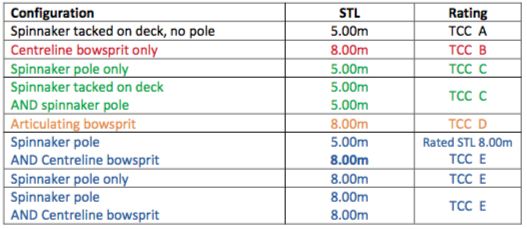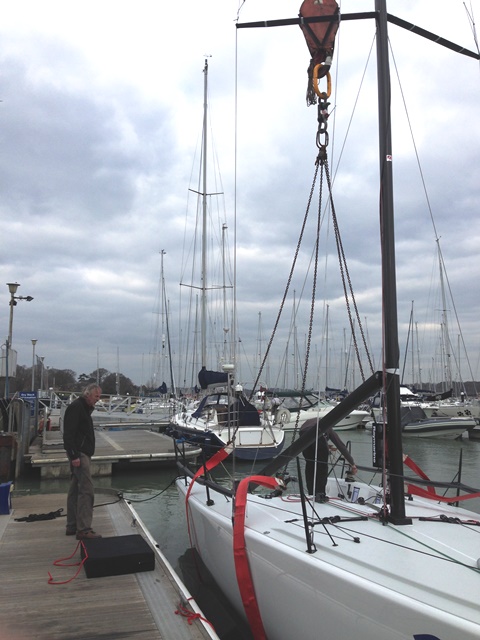Spinnakers and Poles/Bowsprits explained..
 Wednesday, January 24, 2018 at 10:37AM
Wednesday, January 24, 2018 at 10:37AM The RORC Rating Office is sometimes asked whether symmetric and asymmetric spinnakers are rated differently, and whether there is a rating increase if you use both types. The question is often prompted by the IRC application form asking questions about the spinnakers of each type carried aboard, rather than just the largest spinnaker area (SPA) and total number of spinnakers. There are two aspects of downwind sail rating: the sail itself and the type of pole (if any) it is set on - as explained below. Text in italics is taken from the IRC 2018 Rule text.
SPINNAKERS
For the calculation of your rating, IRC considers the largest spinnaker area (SPA) and the total number of spinnakers carried.
21.6 Spinnakers
21.6.1 Boats carrying more than three spinnakers in total on board while racing will incur an increase in rating.
21.6.2 Spinnaker area (SPA) shall be calculated from:
SPA = ((SLU + SLE)/2) * ((SFL + (4 * SHW))/5) * 0.83
SLU, SLE, SFL and SHW of the largest area spinnaker on board shall be declared. The calculated area of this spinnaker will be shown on a boat’s certificate as the maximum permitted SPA.
8.10.1 Values stated on certificates for LH, Hull Beam, Bulb Weight, Draft, x, P, E, J, FL, MUW, MTW, MHW, HLUmax, HSA, PY, EY, LLY, LPY, Cutter Rig HLUmax, SPA, STL are maximum values.
Are symmetric or asymmetric spinnakers rated differently?
Not directly, but see the section on pole type below.
Is there a rating increase if I carry both symmetric and asymmetric spinnakers?
Not directly, but see the section on pole type below.
If not, why does the application form ask how many of each type of spinnaker I carry, and which is the largest?
The information is useful for picking up errors or oversights on the application form before the certificate is issued. For instance if an application form says that the boat carries symmetric spinnakers we would expect the boat to have a spinnaker pole for the symmetric spinnaker.
On revalidation or amendment forms, we ask whether the symmetric or asymmetric spinnaker is the largest because sometimes we will be given data for a new asymmetric spinnaker, for instance, but then find out that the symmetric spinnaker on the last certificate is still the largest.
Requesting this information often means that an owner avoids having to amend their certificate to correct errors.
If the linear measurement data for spinnakers (SLU,SLE,SFL,SHW) are not maximum limiting values, but only largest spinnaker area (SPA), why do you ask for this information?
Rule 21.6.1 states that the linear data shall be supplied for the largest spinnaker, and IRC application forms ask for the linear data for the largest of each type of spinnaker. As above, this is to help the Rating Authority identify possible issues before the certificate is issued.
For instance, we can check that an asymmetric spinnaker complies with the spinnaker definition ie. SHW => 75% SFL. In many cases where this test fails, it is because the SHW measurement has been taken incorrectly and supplied as 50% of actual SHW. Having the linear data also helps us identify typographical input errors, for instance if we get a warning showing a spinnaker is very large or very small we can check the spinnaker data compared with the rig data.
POLE TYPE
The spinnaker type does not affect the rating, but what does make a difference is the way the spinnaker is flown and hence the type of pole you use, if any, and the rated STL (see definition below).
21.3.5 Boats will be rated according to whether they use a spinnaker pole and/or a bowsprit according to the following configurations:
(a) No spinnaker pole (spinnaker tacked on deck) or a centre line bowsprit only.(b) An articulating bowsprit only.
(c) A spinnaker pole or poles either with or without a bowsprit.
STL The greatest horizontal distance from the forward face of the mast spar, measured on or near the centreline of the boat, to any of the following:
- the extremity of the spinnaker pole, whisker pole or bowsprit;
- the spinnaker tack point on deck projected vertically as necessary;
- if a headsail may be tacked forward of the forestay, the headsail tack point on deck projected vertically as necessary or to the extremity of the bowsprit.
Effect on rating of different pole types
It is impossible to estimate the rating effect on pole types for all boats, as this depends on many variables. The only way to get an exact rating for a potential change of configuration is to apply for a trial certificate for your boat (available to boats holding current IRC certificates).
However, the following are examples of different popular configurations, assuming the same spinnaker SPA, with TCC A being the lowest and TCC E the highest:

Information correct November 2017, and may be subject to change in the future.

